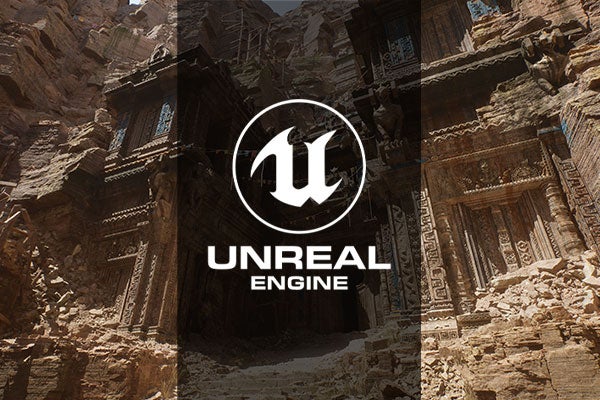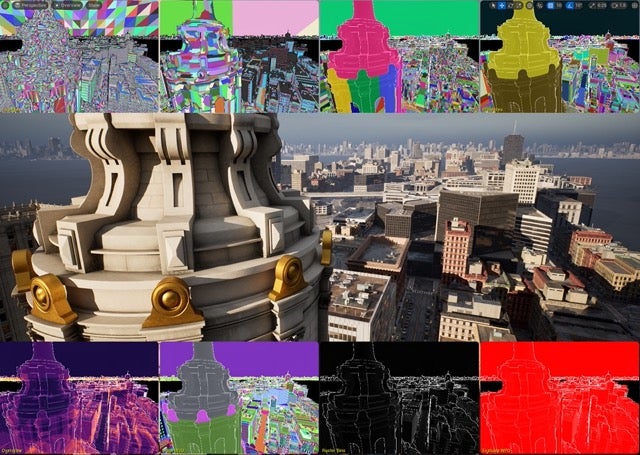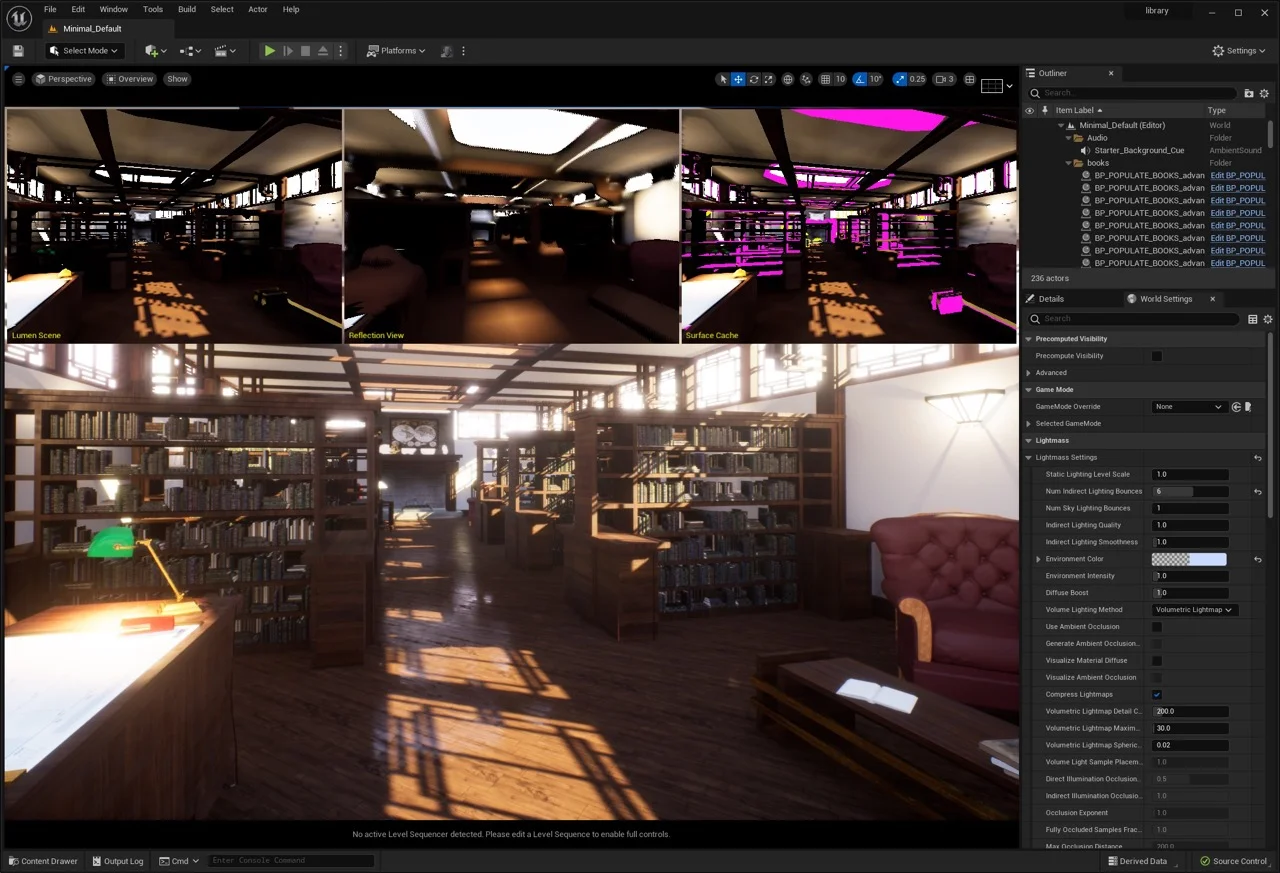
What Is Unreal Engine 5 (UE5)?
Unreal Engine 5 (UE5) is one of the most popular game engines used by game dev teams and creators across industries. Here, we break down what is Unreal Engine 5, the differences between Unreal Engine 4 and Unreal Engine 5, and noteworthy UE5 features. Plus, we'll dive into what you need to take advantage of UE5 and how you can get started today.
Table of Contents
- What Is Unreal Engine 5 (UE5)?
- What Is the Difference Between Unreal Engine 4 and Unreal Engine 5?
- How Does Unreal Engine Licensing Work?
- Unreal Engine 5 Features
- Unreal Engine 5 Benefits
- The Best Version Control for Unreal Engine 5
- Unreal Engine 5 & Perforce
- Get Started with Unreal Engine 5 and Helix Core
➡️ master your art & game assets
Back to topWhat Is Unreal Engine 5 (UE5)?
Unreal Engine 5 (UE5) is the latest version of Unreal Engine, one of the most powerful and popular game engines. Unreal Engine 5 contains the following features: Nanite, Lumen, World Partition system, MetaSounds, and animations.
You can download Unreal Engine 5 here or start with Unreal Engine 4.
What Is the Difference Between Unreal Engine 4 and Unreal Engine 5?
Unreal Engine 4 is a game engine that was released in 2014. Game developers can use UE4 to create games and other virtual assets.
2024 State of Game Technology Report
In a recent survey of game developers, 66 percent of indie developers reported using Unreal Engine for their latest project. Notably, 59 percent of AAA game developers reported using Unreal Engine, making it the most popular game engine used by all game developers surveyed. Learn more insights about the gaming industry and Unreal Engine 5 below:
Compared to Unreal Engine 4, Unreal Engine 5 enables developers to more easily create real-time 3D content and experiences. Additionally, UE5 includes updates to the Unreal Editor and enhanced animation and development tools.
How Does Unreal Engine Licensing Work?
Depending on your team size and needs, Unreal Engine 5 offers three license options:
- Standard License: This license type is free to get started and a good option for creators, publishers, hobbyists, students, and educators.
- Enterprise Program: This license is the best match for non-game professionals and enterprise organizations that need additional support, trainings, and/or custom licensing terms.
- Custom License: The custom license option is for game developers and studios that need additional support, trainings, and/or custom licensing terms.
Unreal Engine 5 Features
Unreal Engine is a staple of game and virtual production development (including technology for other industries like digital twins). With UE5, teams are empowered to build big. Across industries, creators can collaborate in real-time to deliver outstanding visuals and experiences for end users. Let's dive into the features.
Nanite
Unreal Engine 5 goes granular. Nanite is a virtualized geometry system that saves you time when designing massive amounts of geometric detail and enables designers to create a wide range of surfaces.
Nanite also eliminates tedious tasks for loading in level of details (LODs) and allows you to import film-quality art. With Nanite, you can scan and go. And don’t worry, this does not impact performance. You still get a real-time frame rate.

Lumen
Creating a realistic virtual world comes down to the lighting. With a fully dynamic global illuminations and reflections solution, Lumen allows you to create indirect lighting which reacts to direct lighting and geometry.
For instance, lighting can be adjusted to match the time of day, a new light source (like a flashlight), a sudden beam entering the shot, and more. Lumen adjusts lighting from open, dynamic scenes down to the tiniest details.

📘 Related Resource: What Is Virtual Reality (VR) Game Development? Trends, Examples, and Essential Tools for Creating a VR Game
World Partition
Unreal Engine 4 is already known for allowing you to create open worlds. But UE5 takes it to the next level, accelerating the creation of large-scale world building and making it easier to collaborate.
The World Partition system uses a grid to map sublevels of an entire universe. You can manage complex levels that load and unload as a player goes across the landscape. Also, the One File Per Actor system helps teams work in parallel. It reduces overlap by saving data as external files per contributor.

To use this feature, you will need a high-performance version control system (like the one Epic uses). But we will get to that later.
Animations
Innovation requires iteration. Unreal Engine 5 expanded their animation toolset with tools like Control Rig which enables you to create and share rigs across characters. To create more natural movements, you can save and apply poses with the Full-Body IK solver.
In addition, with tools like the Skeletal Editor and Panel Cloth Editor, animators can paint skin weights and add greater dimension to cloth, creating more realistic characters and scenes.
📘 Related Resource: Leveraging Unreal Engine 5 Artifical Intelligence
MetaSounds
If you haven’t tried UE5 yet, this is the reason to start. MetaSounds gives you all the control plus increased flexibility for managing audio. It delivers workflow improvements to help you manage every aspect of a sound experience, enabling you to create a fully procedural audio system.
There are of course more UE5 features out there — a new shadow mapping method, enhanced editors, and streamlined workflows to name a few. Next, we’ll dive into the benefits of Unreal Engine 5 and how creators and game developers are using UE5.
Back to topUnreal Engine 5 Benefits
Unreal Engine 5’s technology is critical for next generation consoles. It has also become critical in helping design 3D worlds that are simple, powerful, and scalable for a wide-range of industries – including architecture, broadcast, live events, automotive and transportation, and film and television.
Here are the UE5 benefits that people are excited about.
UE5 Allows Greater File Sizes
Unreal Engine 5 allows greater file sizes — and the use of 4K, 8K, and 12K textures.Let’s say a player is looking at a cavern and sees a stalagmite. It’s rendered in 4K. But as the player zooms in, the resolution changes dynamically. And the player sees the stalagmite rendered in 12K.
This functionality is incredible. And UE5 makes it possible by handling greater file sizes. As teams work on building games for next-gen consoles like PlayStation 5 and Xbox Series S, they’ll have to be able to handle large files.
To realize the full benefits of Unreal Engine 5, game developers and creators will need to work with a version control system that versions any large files and scales endlessly.
And most game development teams — including 19 of the top 20 AAA game development studios — use Helix Core, version control from Perforce.
Helix Core can scale to handle gigabytes, terabytes, and petabytes of data — assets you need to render in 4K, 8K, and the upcoming 12K. And getting started with Helix Core now is a wise choice if you plan to use UE5.
UE5 Is Fit for Film and Animation Production
Unreal Engine 5’s technological advancements have also majorly impacted the film and entertainment industry, with contributions to over 550 major motion pictures and TV episodes.
Just a few years ago, virtual production was limited to seasoned filmmakers and directors. With the technology and capabilities of Unreal Engine 5, virtual production has become accessible to the larger industry and made waves in animated films, live television, music events, and more.
Unreal Engine 5 provides creators with an extensive virtual production toolset, a cinematic editing and animation tool called Sequencer, and the ability to create final-pixel output for their content.
📘Related Resource: Virtual Production Setup: The Entertainment Technology Center Case Study
Maximize Unreal Engine 5 with VFX Training
Make the most of your investment in Unreal Engine with free virtual production training from Perforce U.
But before you dive into the new features, discover what you need in your toolset to get the most out of UE5.
The Best Version Control for Unreal Engine 5
Many teams using Unreal Engine 5 also use a version control system – an essential tool for storing assets, managing changes to files over time, and enabling global teams to collaborate.
19 of the top 20 AAA game dev studios use Helix Core. So do countless indie studios who are also using Unreal Engine 5.
Perforce Helix Core is the game development industry standard for version control. It provides a globally capable infrastructure to manage millions of files, and extremely large files in support of innovative teams across industries using Unreal Engine.
📘 Related Resource:Game Development Process: How Game Development Works
Unreal Engine 5 & Perforce
Unreal Engine has a longstanding built-in integration with Helix Core. Epic Games, the developer of Unreal Engine, encourages third party developers using Unreal to also use Helix Core. The two tools are tightly integrated, which helps your team work together more efficiently on projects.
Helix Core and Unreal Engine are critical to the game development process, helping developers building the great games of tomorrow. Both are used to innovate, collaborate, and deliver award-winning, immersive experiences.
Watch the video below to see how you can set up Helix Core with Unreal — and start collaborating better.
Here’s how Helix Core’s integrations with Unreal Engine 5 work:
- Unreal Editor easily and seamlessly integrates with Helix Core. This integration is built and maintained by Epic.
- Unreal Game Sync (UGS) is also a tool built by Epic which helps distribute compiled binaries to non-developers, such as artists and designers. Perforce Helix Core is required to use UGS.
- Microsoft Visual Studio integrates with both Helix Core and Unreal Engine. Helix Core’s plugin is called P4VS.
- Graphics tools integrate with Helix Core, too, with P4GT. But we also offer Helix Sync, which removes complexity for artists and designers. They can simply drop-and-drag to version.
📺 Related Resource:How to Collaborate in Unreal Engine (Some Best Practices)
These integrations are why the world’s most successful game development teams choose Helix Core and Unreal Engine 5.
Unreal Engine 5 and Helix DAM
Built on top of Helix Core, Helix DAM is a digital asset management tool that provides a visual web-based UI to empower teams by streamlining creative workflows, which makes it simple to store, find, use, repurpose, review, and share creative assets all in one place.
Considering the number and file size of assets needed to create AAA games with Unreal Engine 5, it is more important than ever to have a limitless and integrated visual library, housing not only all the files within one project, but your studio or organization’s complete asset history.
Back to topHelix Dam— Digital Asset Management by Perforce
Try Helix DAM free with Unreal Engine 5, no commitment or setup necessary.
Get Started with Unreal Engine 5 and Helix Core
See for yourself why you should get started with Helix Core and Unreal Engine 5— for game development, film, animation, and beyond. Use it free for up to 5 users and scale up as your team and files grow.
➡️ Start using HELIX CORE FREE + UE5
Back to top
